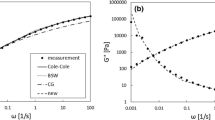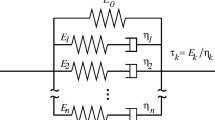Abstract
Nonlinear Tikhonov regularization within a Bayesian framework is incorporated into a computer program called pyReSpect, which infers the continuous and discrete relaxation spectra from oscillatory shear experiments. It uses Bayesian inference to provide uncertainty estimates for the continuous spectrum h(τ) by propagating the uncertainty in the regularization parameter λ. The new algorithm is about 6–9 times faster than an older version of the program (ReSpect) in which the optimal λ was determined by the L-curve method. About half of the speedup arises from the Bayesian formulation by restricting the window of λ explored. The other half arises from the nonlinear formulation for which the spectrum is a weak function of λ, allowing us to use a coarse mesh for λ. The program is tested and validated on three examples: a synthetic spectrum, a H-polymer, and an elastomer with a nonzero terminal plateau.









Similar content being viewed by others
References
Anderssen RS, Davies AR (2001) Simple moving-average formulae for the direct recovery of the relaxation spectrum. J Rheol 45(1):1–27
Ankiewicz S, Orbey N, Watanabe H, Lentzakis H, Dealy J (2016) On the use of continuous relaxation spectra to characterize model polymers. J Rheol 60(6):1115–1120
Bae JE, Cho KS (2015) Logarithmic method for continuous relaxation spectrum and comparison with previous methods. J Rheol 59:1081
Baumgaertel M, Derosa ME, Machado J, Masse M, Winter HH (1992) The relaxation-time spectrum of nearly monodisperse polybutadiene melts. Rheol Acta 31:75–82
Baumgaertel M, Winter H (1992) Interrelation between continuous and discrete relaxation time spectra. JNon-Newt Fluid Mech 44(0):15–36
Baumgaertel M, Winter HH (1989) Determination of discrete relaxation and retardation time spectra from dynamic mechanical data. Rheol Acta 28(6):511–519
Brabec CJ, Rogl H, Schausberger A (1997) Investigation of relaxation properties of polymer melts by comparison of relaxation time spectra calculated with different algorithms. Rheol Acta 36:667–676
Branch M, Coleman T, Li Y (1999) A subspace, interior, and conjugate gradient method for large-scale bound-constrained minimization problems. SIAM J Sci Comput 21(1):1–23
Cho KS (2010) A simple method for determination of discrete relaxation time spectrum. Macromol Res 18 (4):363–371
Cho KS, Park GW (2013) Fixed-point iteration for relaxation spectrum from dynamic mechanical data. J Rheol 57(2):647–678
Davies AR, Anderssen RS (1997) Sampling localization in determining the relaxation spectrum. J Non-Newton Fluid Mech 73(1-2):163–179
Ferry J (1980) Viscoelastic properties of polymers., 3rd. John Wiley & Sons Inc, Hoboken, NY
Goyal S, Larson RG, Aloisio CJ (1999) Quantitative prediction of impact forces in elastomers. J Engg Mat Tech 121(3):294– 304
Hansen P (1992) Analysis of discrete ill-posed problems by means of the L-curve. SIAM Rev 34(4):561–580
Hansen PC, O’Leary DP (1993) The use of the Lhul-curve in the regularization of discrete ill-posed problems. SIAM J Sci Comp 14(6):1487–1503
Hansen S (2000) Bayesian estimation of hyperparameters for indirect Fourier transformation in small-angle scattering. J Appl Cryst 33(6):1415–1421
Hansen S (2008) Estimation of the relaxation spectrum from dynamic experiments using Bayesian analysis and a new regularization constraint. Rheol Acta 47:169–178
Honerkamp J, Weese J (1989) Determination of the relaxation spectrum by a regularization method. Macromolecules 22(11):4372–4377
Honerkamp J, Weese J (1993) A nonlinear regularization method for the calculation of relaxation spectra. Rheol Acta 32(1):65–73
Hulsen MA, van der Zanden J (1991) Numerical simulation of contraction flows using a multi-mode Giesekus model. J Non-Newton Fluid Mech 38(2):183–221
Ianniruberto G, Marrucci G (2002) A multi-mode CCR model for entangled polymers with chain stretch. J Non-Newton Fluid Mech 102(2):383–395
Inkson NJ, McLeish TCB, Harlen OG, Groves DJ (1999) Predicting low density polyethylene melt rheology in elongational and shear flows with “pom-pom” constitutive equations. J Rheol 43(4):873–896
Jensen EA (2002) Determination of discrete relaxation spectra using simulated annealing. J Non-Newton Fluid Mech 107(1-3): 1–11
Johnston P, Gulrajani R (2000) Selecting the corner in the L-curve approach to Tikhonov regularization. IEEE Trans Biomed Engg 47(9):1293–1296
Jones E, Oliphant T, Peterson P et al (2001) SciPy: open source scientific tools for Python. http://www.scipy.org/, [Online; accessed <today>]
Kaschta J, Stadler F (2009) Avoiding waviness of relaxation spectra. Rheol Acta 48(6):709–713
Larson RG, Goyal S, Aloisio C (1996) A predictive model for impact response of viscoelastic polymers in drop tests. Rheol Acta 35(3):252–264
Lentzakis H (2014) Linear and non-linear rheological architecture of architecturally complex polymers. Ph.D thesis. University of Crete, Greece
Macdonald JR (2000) On relaxation-spectrum estimation for decades of data: accuracy and sampling-localization considerations. Inverse Probl 16:1561–1583
McDougall I, Orbey N, Dealy JM (2014) Inferring meaningful relaxation spectra from experimental data. J Rheol 58:779
Mead DW (1994) Determination of molecular-weight distributions of linear flexible polymers from linear viscoelastic material functions. J Rheol 38:1797–1827
Orbey N, Dealy JM (1991) Determination of the relaxation spectrum from oscillatory shear data. J Rheol 35(6):1035–1049
Provencher SW (1976) An eigenfunction expansion method for the analysis of exponential decay curves. J Chem Phys 64(7):2772–2777
Provencher SW (1982) CONTIN: a general purpose constrained regularization program for inverting noisy linear algebraic and integral equations. Comp Phys Comm 27(3):229–242
Ronca G (1983) Frequency spectrum and dynamic correlations of concentrated polymer liquids. J Chem Phys 79(2):1031–1043
Roovers J (1984) Melt rheology of h-shaped polystyrenes. Macromolecules 17(6):1196–1200
Roovers J, Toporowski PM (1981) Preparation and characterization of H-shaped polystyrene. Macromolecules 14(5):1174–1178
Roths T, Marth M, Weese J, Honerkamp J (2001) A generalized regularization method for nonlinear ill-posed problems enhanced for nonlinear regularization terms. Comp Phys Comm 139(3):279–296
Shanbhag S (2019) pyReSpect: a computer program to extract discrete and continuous spectra from stress relaxation experiments. Macromol Theory Simul 28(3):1900005
Shanbhag S, Park SJ, Wang Z (2012) Superensembles of linear viscoelastic models of polymer melts. J Rheol 56(2):279–303
Stadler F, Bailly C (2009) A new method for the calculation of continuous relaxation spectra from dynamic-mechanical data. Rheol Acta 48(1):33–49
Takeh A, Shanbhag S (2013) A computer program to extract the continuous and discrete relaxation spectra from dynamic viscoelastic measurements. Appl Rheol 23(2):24628
Weese J (1992) A reliable and fast method for the solution of Fredholm integral equations of the first kind based on Tikhonov regularization. Comp Phys Comm 69(1):99–111
Weese J (1993) A regularization method for nonlinear ill-posed problems. Comp Phys Comm 77(3):429–440
Winter HH (1997) Analysis of dynamic mechanical data: inversion into a relaxation time spectrum and consistency check. J Non-Newton Fluid Mech 68:225–239
Acknowledgments
This work is based in part upon work supported by the National Science Foundation under grant no. NSF DMR-1727870.
Author information
Authors and Affiliations
Corresponding author
Ethics declarations
Conflict of interests
The authors declare that they have no conflict of interest.
Additional information
Publisher’s note
Springer Nature remains neutral with regard to jurisdictional claims in published maps and institutional affiliations.
Appendix: Linearity of the CRS with regularization parameter
Appendix: Linearity of the CRS with regularization parameter
What property of the problem leads to the general observation \(\partial ^{2} H_{\lambda }/\partial (\log \lambda )^{2} \approx 0\)? Since \(H = \log h\), we intuitively understand that deviations in H are mild compared to deviations in h. Nevertheless, we can show using a toy example that the linearity of \(H(\log \lambda )\) stems from the form of the cost function.
For simplicity, and without loss of generality, suppose that H is a variable rather than a function H(τ). Let, V (λ,H) = ρ2(H) + λη2(H) be a cost function that is linear in λ, but nonlinear in H. Furthermore, suppose
where λ∗ is any particular λ, not necessarily the optimal λ. Let R(H) = dρ2(H)/dH and N(H) = dη2(H)/dH, be the first derivatives. Optimality conditions imply
Let R+ = R(H+), N+ = N(H+), R∗ = R(H∗), and N∗ = N(H∗). For slowly varying functions, a Taylor series expansion implies
Ignoring quadratic and higher order terms, and setting c1 = dR(H∗)/dH and c2 = dN(H∗)/dH,
If c2λ ≫ c1, then (H+ − H∗)/(λ − λ∗) = ΔH/Δλ ≈−N∗/(c2λ). Thus,
Rights and permissions
About this article
Cite this article
Shanbhag, S. Relaxation spectra using nonlinear Tikhonov regularization with a Bayesian criterion. Rheol Acta 59, 509–520 (2020). https://doi.org/10.1007/s00397-020-01212-w
Received:
Revised:
Accepted:
Published:
Issue Date:
DOI: https://doi.org/10.1007/s00397-020-01212-w




